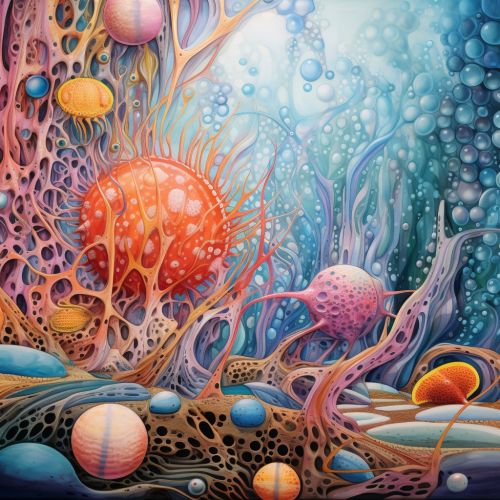Biological Mechanisms
Introduction
Biological mechanisms refer to the series of biochemical processes that facilitate life in organisms. These mechanisms encompass a wide range of activities, including cellular respiration, DNA replication, protein synthesis, and cell division, among others. This article delves into the intricate details of these mechanisms, shedding light on the complex nature of biological systems.


Cellular Respiration
Cellular respiration is a set of metabolic reactions that convert biochemical energy from nutrients into adenosine triphosphate (ATP), and then release waste products. The reactions involved in respiration are catabolic reactions, which break down large molecules into smaller ones, releasing energy in the process. This process is vital for the survival of cells, as ATP serves as the main energy source for metabolic functions.
Glycolysis
Glycolysis is the first stage of cellular respiration, occurring in the cytoplasm of the cell. It involves the breakdown of glucose into two molecules of pyruvate, producing a net gain of two ATP molecules and two nicotinamide adenine dinucleotide (NADH) molecules. This process does not require oxygen and is therefore an anaerobic process.
Krebs Cycle
Following glycolysis, the pyruvate molecules enter the mitochondria where they undergo the Krebs cycle, also known as the citric acid cycle. This cycle involves a series of chemical reactions that generate energy through the oxidation of acetyl-CoA derived from carbohydrates, fats, and proteins into ATP and carbon dioxide.
Electron Transport Chain
The final stage of cellular respiration is the electron transport chain, which takes place in the inner mitochondrial membrane. Here, electrons from NADH and FADH2 are transferred through a series of proteins, leading to the pumping of protons across the membrane and creating a proton gradient. This gradient drives the synthesis of ATP through a process known as oxidative phosphorylation.
DNA Replication
DNA replication is the biological process by which an exact copy of a DNA molecule is created. This process is crucial for cell division, as each new cell requires a complete set of DNA molecules to function properly.
Initiation
The initiation of DNA replication begins at specific locations in the genome called origins of replication. At these sites, various proteins work together to separate the DNA strands and form a replication fork, a Y-shaped structure where new DNA strands are synthesized.
Elongation
During the elongation phase, enzymes known as DNA polymerases add nucleotides to the growing DNA strand in a 5' to 3' direction. The leading strand is synthesized continuously, while the lagging strand is synthesized in fragments known as Okazaki fragments.
Termination
Replication ends when the new DNA molecules are fully formed. The replication machinery disassembles and the DNA strands reseal to form two identical DNA molecules.
Protein Synthesis
Protein synthesis is the process by which cells generate new proteins. It involves two main stages: transcription and translation.
Transcription
Transcription is the first step in protein synthesis. It occurs in the nucleus and involves the synthesis of messenger RNA (mRNA) from a DNA template. The enzyme RNA polymerase binds to a specific sequence on the DNA strand and synthesizes an mRNA molecule.
Translation
Translation is the second stage of protein synthesis, occurring in the cytoplasm. Here, the mRNA molecule is decoded by a ribosome to produce a specific amino acid chain, or polypeptide. This polypeptide will later fold into an active protein and perform its functions in the cell.
Cell Division
Cell division is a biological process by which a parent cell divides into two or more daughter cells. It is a crucial process in the life cycle of a cell, allowing for growth, reproduction, and repair in organisms.
Mitosis
Mitosis is a type of cell division that results in two daughter cells each having the same number and kind of chromosomes as the parent nucleus. It is generally followed by cytokinesis which divides the cytoplasm, organelles and cell membrane.
Meiosis
Meiosis, on the other hand, is a type of cell division that reduces the number of chromosomes in the parent cell by half and produces four gamete cells. This process is required to produce egg and sperm cells for sexual reproduction.
